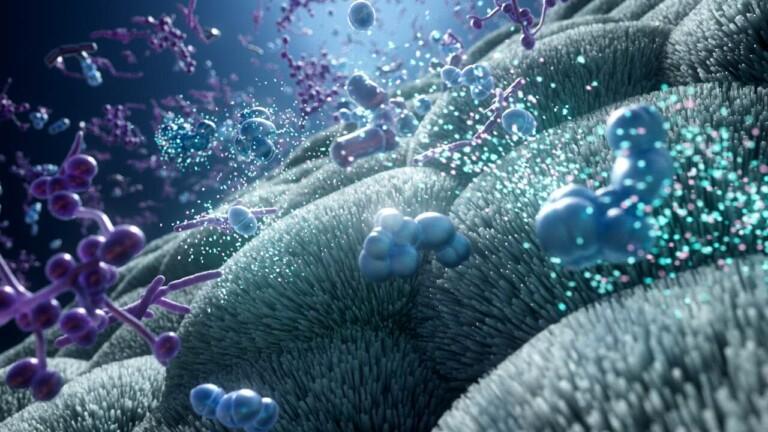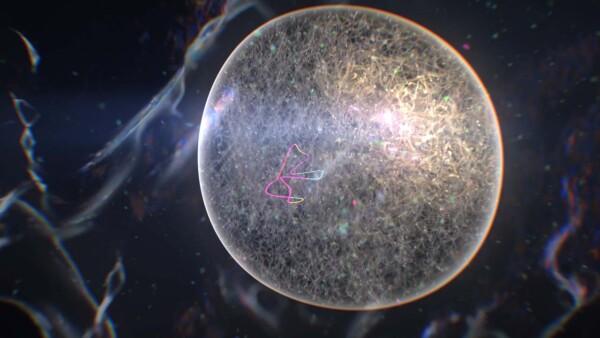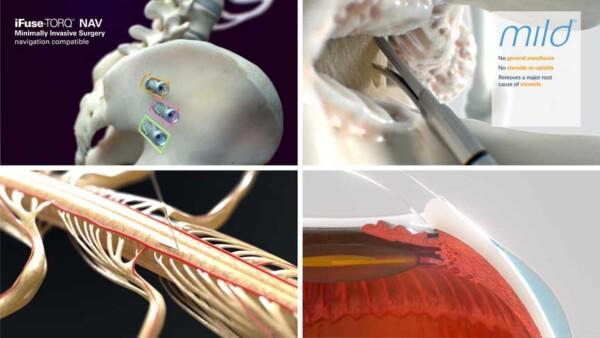
Medical Animation Production—What to Expect From Start to Finish
By: Cameron Slayden
Medical animation is an industry-standard method of scientific communication. In the pharmaceutical, medical device, and biotechnology industries, it's used to explain the hard science and features behind their technologies or therapies in the most efficient format possible.
An entire industry has grown around providing for these needs at multiple price points. Commissioning this kind of work can be a considerable investment. This article will walk you through what to expect when embarking on this journey.
The Elements of Medical Animation Production
Microverse Studio’s production page lays out our specific protocol, but the phases outlined in this article go more in-depth, and should apply to just about any studio out there. These milestones were established organically over decades of experimentation. They represent the key touch points necessary for successful medical animation production. At Microverse Studios, we have found that this project flow optimizes production efficiency, without wasting client or animator time. Anything less runs the risk of an end product that doesn't meet (or exceed!) client expectations.
Briefly, here are the major production steps you should anticipate from your vendor when commissioning a medical animation:
- Scope/Discovery
- Script
- Style
- Storyboard
- Asset Assembly
- Rendering
- Compositing
- Editing
- Review
- Professional Voice, Sound, and Music
- Ancillary Deliverables
Scope/Discovery for Medical Animation
Every medical animation studio has their own method to identify how much work will go into a project, and thus cost. This tends to center around the duration of the end product. Sometimes, studios will use the word count of the script as a metric (120 words per minute), because that's a hard determiner of absolute duration.
However, we've found that there's a better way: we tie cost to the number of events taking place on screen. After all, everything that happens in a medical animation takes work to create. Sometimes an event may be easy to build and animate, but require an unusual number of words in the narration.
The human brain takes about 10 seconds to absorb a piece of information and move it from short term memory to long term memory, where it can be incorporated into a narrative. If information is presented too quickly, the brain dumps whatever it’s thinking about to make room for the next idea, and the message doesn’t get absorbed. If ideas are presented too slowly, the brain can’t easily sequence them into a coherent narrative.
If we add a second to each side of each idea for transitions, that makes the optimal pace of storytelling about 5 ideas per minute. This precisely ties the amount of labor to the end duration of the animation, making for a predictable production experience and minimizing scope creep.
Pricing based on number and complexity of onscreen events guarantees the most accurate rate. This way, scope is easily maintained by writing the narration around the important events and planning them visually in the storyboard.
Medical Animation Script
The script is the conceptual backbone of any animation, and that includes medical animation. It's important to keep spoken content grounded in verbiage that enhances onscreen events. It's also a good idea to avoid exposition. Verbiage that describes concepts that can't be directly animated risk confusing or boring viewers.
The narration is also an opportunity to inject principles of story structure into the production. With the right application, story structure can deeply enrich viewer interest.
Developing the Style for a Medical Animation
Most studios explore look and feel before starting medical animation production. If done well, look development can inject a strong aesthetic into the final product. It’s important to have key stakeholders involved in this conversation to make sure that everyone is happy with the visual approach. Often, the style developed at this stage becomes central to a product or company’s brand, so the stakes are high.
At Microverse Studios, we also create concept art to further explore how the style will apply to the scientific imagery. This way, the project begins with design documents that give a good sense of how the scientific imagery will look. This starts every project in alignment with client expectations.
Medical Animation Storyboards
A storyboard is usually created as a hand-drawn “sketch phase” for the animation. It establishes exactly what happens on screen during narration. Medical animation often includes very complicated scientific concepts. The storyboard is central to aligning client expectations with the animators' approach.
Sometimes storyboards are series of detailed digital paintings depicting every event taking place. Sometimes they are simple black-and-white sketches of those events. In either case, they serve a critical early alignment on the visual plan for the story.
Medical Animation Asset Assembly
Medical animation production begins with assembly of the geometries and images that will go into creating the final video. Sometimes these elements are sourced externally. Examples might be protein structures or gross anatomy or CAD files. In medical animation, the visual subjects tend to be complicated. Often they need to be created from scratch. At Microverse Studios, every project we produce is bespoke, and so we create all elements new for each project.
Lights are set into the scenes, the appearances of the materials designed, and the look and feel of the imagery is established. At Microverse Studios, we provide stills at this phase to give clients an early look at final imagery.
One of the assets produced during this phase is the initial narration track. Stand-in voice in the first version gives the script a final gut-check before recording with the professional voice talent.
Rendering the Medical Animation Components
The 3D build files are then converted into a series of frames in a process called rendering. This can be computationally intensive, depending on the software features the animators use. If a medical animation renders on an artist's workstation, it can often take hours or days to complete. A production bottleneck forms, even when rendering on a local computer "farm."
Artists working this way have to cut corners to speed the render process, which can impact quality. This is especially true when under deadline or rendering many projects in parallel.
Recently, other options have become available. Cost-effective supercomputing resources, such as Conductor by Coreweave, provide hollywood-level render capacity. This processing power allows animators to create their best work on every project.
Compositing for Medical Animation
Lens flare, on screen text, color correction, and other image “sweetening” is often added after rendering is complete. This requires video processing software such as Nuke, Fusion, or Adobe After Effects. Footage elements are layered over one another and effects are applied to create the final look. The final footage sequences render once again from this software to create footage sequences ready for the final edit.
Editing Medical Animation Footage
Editing is an art form unto itself. It’s said that perfect editing is invisible. When done right, it creates a precisely paced story and a seamless viewing experience. No uncomfortable pauses, no jumpy transitions. The story flow just… feels right. Stand-in narration and music are carefully mixed and laid in. The entire production is output as a whole to become the first version of the video, ready to watch.
Reviewing the Completed Medical Animation
Modern technology has made delivery and deployment of animation easy. Every studio will have their own toolset for delivery and review. We use Vimeo because it can deliver a link that can be viewed and commented on from any device. This is also important because the vast majority of medical animation is consumed on mobile devices.
At Microverse Studios, animations undergo internal review before we deliver each version to clients. After receiving feedback, our creatives meet with the client to ensure we understand the feedback fully, and to align on the plan to address it. Microverse Studios’ standard contract allows 3 rounds of refinement, although usually our projects are accepted as final after just one.
Professional Voice, Sound, and Music for Medical Animation
The client selects final voice talent from a collection of auditions. Microverse Studios has a stable of voice talent that we present to clients, but occasionally clients ask us to put out an additional casting call or contract with celebrity talent (one client wanted Edward James Olmos, and another wanted JK Simmons!). Once the edit is approved, sound effects and final music are mixed and laid in along with the final voice.
Derivative Deliverables from Medical Animation
High quality medical animation is an investment. Most studios want/expect their work to be a centerpiece for their clients’ communications strategies. Microverse Studios makes this easy by including unlimited alternate edits (such as sequence extractions or shorter versions) and still images from the video at no extra cost.
| A Thought About Weekly Status Update Meetings: Between milestones, everything is in-progress and incomplete. Often, in-progress tasks are complex and technical, and hard to communicate to non-animators. The actual reviewable material isn't ready to view until the next milestone. When clients ask for weekly meetings, they often consist of the animators saying, "We're on target for the next milestone." In other words, a meeting that could have been an email. |
Medical Animation Production Studios
When it comes to highly specialized and complex fields found in biotechnology, it's important to choose teams with optimal backgrounds. Specially trained scientific or medical animators will be able to fully understand the story they are animating. This will ensure scientific accuracy, which is critical in medical animation. It will also breathe scientific detail, nuance, and richness into the imagery.
Strong filmmaking skills will also enhance the production quality of the end product. During the production phase, our medical animators use a variety of tools to animate each event outlined in the storyboard. This task calls upon a blend of programming, simulation design, and puppeteering skills. It also requires understanding of molecular and cellular biology, as well as tissue and fluid dynamics.
Finally, a medical animation studio's internal review process will be critical to achieving the best possible outcomes. Motion elements are refined and iterated upon using unfinished renders. These “animatics” are rarely shared with clients, because they don’t look like the finished product. The animators work in a specialized 3D interface that can be difficult to interpret.
Commissioning Your Next Medical Animation
The first step, of course, will be to find out if medical animation is the right choice for you. While animation is an effective communications tool, it’s not not appropriate for every situation. The studio you work with should have input on what the best applications for animation are. They will be able to review your message and either propose an approach to animation for you, or recommend an alternative that would be more cost-effective or efficient if animation isn’t the best choice.
If you'd like to learn more about how Microverse Studios' medical animation can tell your story, get in touch! We can set up a brief 15-30 minute conversation to discuss your new technology and whether it could benefit from what we have to offer.
You might also like

Cameron Slayden is CEO of Microverse Studios, and has over 20 years of experience in biomedical visualization. To find out more, check him and the rest of our team out on the Who We Are page.



